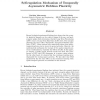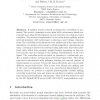32 search results - page 4 / 7 » Phenomenological models of synaptic plasticity based on spik... |
IJCNN
2008
IEEE
14 years 1 months ago
2008
IEEE
— Spiking neural networks have been shown capable of simulating sigmoidal artificial neural networks providing promising evidence that they too are universal function approximat...
ICONIP
2007
13 years 9 months ago
2007
We proposed a neural segmentation model that is suitable for implementation in analog VLSIs using conventional CMOS technology. The model consists of neural oscillators mutually co...
NECO
2007
13 years 7 months ago
2007
Learning agents, whether natural or artificial, must update their internal parameters in order to improve their behavior over time. In reinforcement learning, this plasticity is ...
NIPS
2001
13 years 9 months ago
2001
Recent biological experimental findings have shown that the synaptic plasticity depends on the relative timing of the pre- and postsynaptic spikes which determines whether Long Te...
IWANN
2005
Springer
14 years 1 months ago
2005
Springer
Abstract. A spiking neural network modeling the cerebellum is presented. The model, consisting of more than 2000 conductance-based neurons and more than 50 000 synapses, runs in re...


